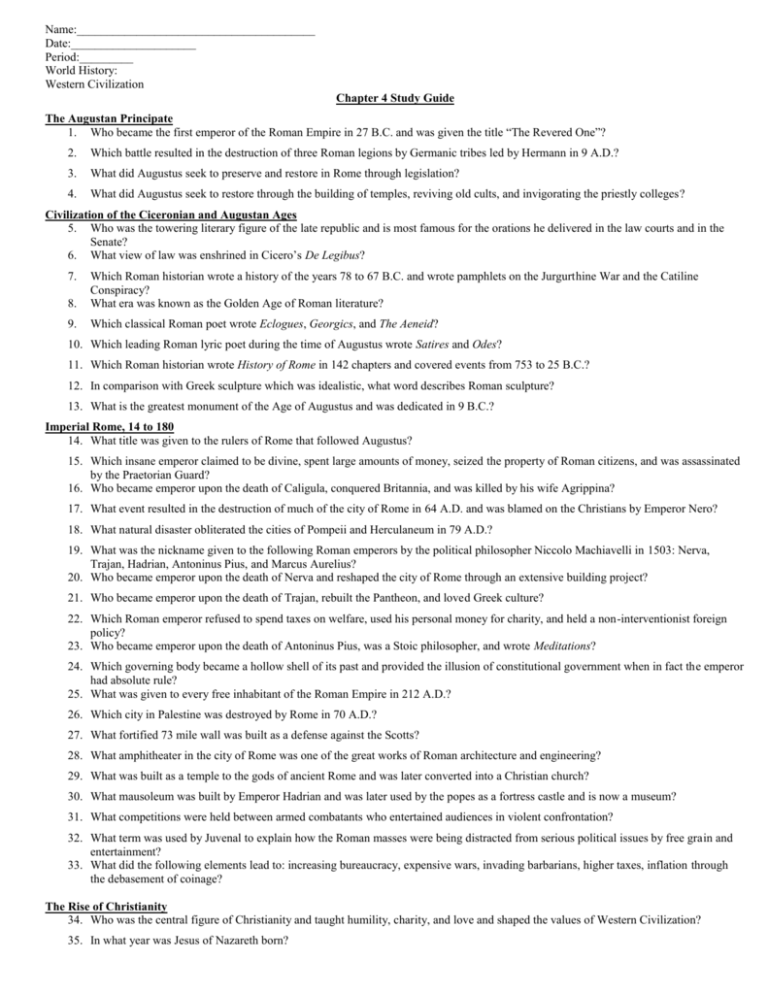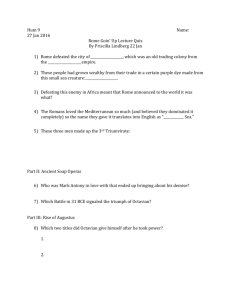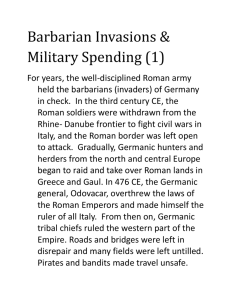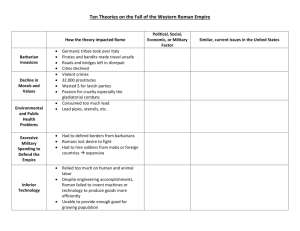Chapter 4 Study Guide - morganhighhistoryacademy.org
advertisement

Name:________________________________________ Date:_____________________ Period:_________ World History: Western Civilization Chapter 4 Study Guide The Augustan Principate 1. Who became the first emperor of the Roman Empire in 27 B.C. and was given the title “The Revered One”? 2. Which battle resulted in the destruction of three Roman legions by Germanic tribes led by Hermann in 9 A.D.? 3. What did Augustus seek to preserve and restore in Rome through legislation? 4. What did Augustus seek to restore through the building of temples, reviving old cults, and invigorating the priestly colleges? Civilization of the Ciceronian and Augustan Ages 5. Who was the towering literary figure of the late republic and is most famous for the orations he delivered in the law courts and in the Senate? 6. What view of law was enshrined in Cicero’s De Legibus? 7. 8. Which Roman historian wrote a history of the years 78 to 67 B.C. and wrote pamphlets on the Jurgurthine War and the Catiline Conspiracy? What era was known as the Golden Age of Roman literature? 9. Which classical Roman poet wrote Eclogues, Georgics, and The Aeneid? 10. Which leading Roman lyric poet during the time of Augustus wrote Satires and Odes? 11. Which Roman historian wrote History of Rome in 142 chapters and covered events from 753 to 25 B.C.? 12. In comparison with Greek sculpture which was idealistic, what word describes Roman sculpture? 13. What is the greatest monument of the Age of Augustus and was dedicated in 9 B.C.? Imperial Rome, 14 to 180 14. What title was given to the rulers of Rome that followed Augustus? 15. Which insane emperor claimed to be divine, spent large amounts of money, seized the property of Roman citizens, and was assassinated by the Praetorian Guard? 16. Who became emperor upon the death of Caligula, conquered Britannia, and was killed by his wife Agrippina? 17. What event resulted in the destruction of much of the city of Rome in 64 A.D. and was blamed on the Christians by Emperor Nero? 18. What natural disaster obliterated the cities of Pompeii and Herculaneum in 79 A.D.? 19. What was the nickname given to the following Roman emperors by the political philosopher Niccolo Machiavelli in 1503: Nerva, Trajan, Hadrian, Antoninus Pius, and Marcus Aurelius? 20. Who became emperor upon the death of Nerva and reshaped the city of Rome through an extensive building project? 21. Who became emperor upon the death of Trajan, rebuilt the Pantheon, and loved Greek culture? 22. Which Roman emperor refused to spend taxes on welfare, used his personal money for charity, and held a non-interventionist foreign policy? 23. Who became emperor upon the death of Antoninus Pius, was a Stoic philosopher, and wrote Meditations? 24. Which governing body became a hollow shell of its past and provided the illusion of constitutional government when in fact the emperor had absolute rule? 25. What was given to every free inhabitant of the Roman Empire in 212 A.D.? 26. Which city in Palestine was destroyed by Rome in 70 A.D.? 27. What fortified 73 mile wall was built as a defense against the Scotts? 28. What amphitheater in the city of Rome was one of the great works of Roman architecture and engineering? 29. What was built as a temple to the gods of ancient Rome and was later converted into a Christian church? 30. What mausoleum was built by Emperor Hadrian and was later used by the popes as a fortress castle and is now a museum? 31. What competitions were held between armed combatants who entertained audiences in violent confrontation? 32. What term was used by Juvenal to explain how the Roman masses were being distracted from serious political issues by free grain and entertainment? 33. What did the following elements lead to: increasing bureaucracy, expensive wars, invading barbarians, higher taxes, inflation through the debasement of coinage? The Rise of Christianity 34. Who was the central figure of Christianity and taught humility, charity, and love and shaped the values of Western Civilization? 35. In what year was Jesus of Nazareth born? 36. What do the initials B.C. and A.D. represent when specifying a historical era? 37. According to the followers of Jesus, what happened to him on the third day after his death in 33 A.D.? 38. What monotheistic religion is based on the life and teachings of Jesus? 39. Which early Christian leader was the leader of the Twelve Apostles and was crucified in Rome? 40. Who was the most influential early Christian missionary and wrote many epistles of the New Testament? 41. List three reasons for the growth of Christianity: 42. What made Christianity stronger, organized, and more committed? 43. What name was given to the body of majority opinion, considered to be universal and was enshrined by the Church? 44. What collection of works was written at different times by various authors and became the foundation for Christian doctrine? 45. What four books make up the Canonical Gospels found in the New Testament? 46. What became the most important center of Christianity? The Crisis of the Third Century 47. What century was known for economic crisis, plague, civil war, invasion, and military anarchy? 48. Who were the most aggressive of the Germans in the third century A.D.? 49. What did emperors do to the coinage in order to pay for government ventures which resulted in inflation? The Late Empire 50. Which emperor divided Rome into four units and founded a Tetrarchy in 293 A.D.? 51. What battle took place between Roman emperors Constantine and Maxentius and resulted in a victory for Constantine and unified the Roman Empire? 52. Which two emperors embarked upon political and military reform that resulted in an increased army and civil service, but drained most of the public funds? 53. What imperial city was established by Constantine in 330 A.D. that replaced Rome as the capital of the Roman Empire? 54. List three groups of people that besieged the Western Roman Empire: 55. What battle was fought between Rome led by Valens and Gothic invaders in 378 A.D. and resulted in crushing defeat for the Romans and signaled the beginning of the final collapse of the Western Roman Empire? 56. What culture flourished in Constantinople, became known as the Eastern Roman Empire, and lasted until the 15 th century? 57. What proclaimed official tolerance of Christianity in 313 A.D.? 58. What council was convoked by Constantine in 325 A.D. and was the first effort to attain consensus in the church and established canon law? 59. Who became the first Christian Emperor? 60. Which Roman emperor made Christianity the official religion of Rome in 380 A.D.? Arts and Letters in the Late Empire 61. Who was thoroughly trained in classical Latin literature and produced a revised version of the Bible in Latin which became the Bible of the Catholic Church? 62. Which important eastern scholar wrote Ecclesiastical History which set forth the Christian view of history? 63. Which theologian influenced the development of Christianity and wrote Confessions and The City of God? The Decline and Fall of the Roman Empire in the West 64. What attack on Rome in 410 A.D. by the Visigoths was a major landmark in the decline and fall of Western Rome? 65. What year is given for the fall of the Western Roman Empire? List ten reasons for the decline and fall of the Roman Empire in the West: 66. 67. 68. 69. 70. 71. 72. 73. 74. 75.









